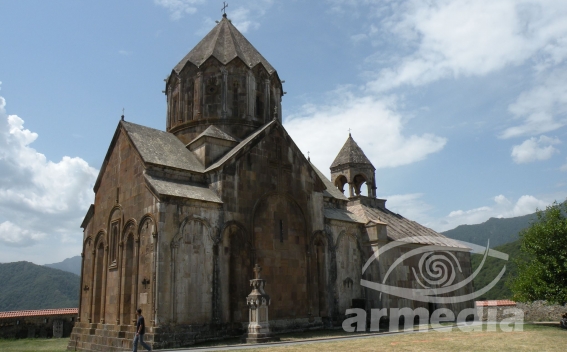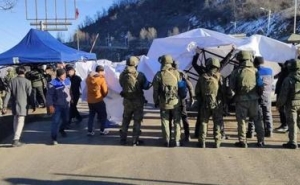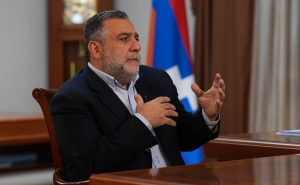Gandzasar: World’s Architectural Masterpiece

This year Armenian celebrated the 777th anniversary of the Gandzasar Monastery. The monastery was consecrated on July 22, 1240. Its construction was completed in 1238. Gandzasar is now the seat of the Archbishop of Artsakh appointed by the Mother See of Holy Etchmiadzin of the Armenian Apostolic Church.
Gandzasar Monastery is in the Artsakh Province of Mets Hayq (the Kingdom of Greater Armenia (321 BC to 428 AD)) (near today’s Vank village in Martakert Region of Artsakh (Nagorno-Karabakh Republic). It is situated on Gandzasar Mountain (in Armenian "Gandzasar" means "mountain of treasures"), hereby the name of the monastery. According to the existing folklore the mountain got its name from the rich silver supplies it contained.
The main sightseeing of Gandzasar Monastery is St. Hovhannes Mkrtich Cathedral. It is believed that the monastery holds relics belonging to Hovhannes Mkrtich and his father St. Zechariah.
A member of the Hermitage Board of scientists, famous Soviet historian and art critic Anatoly Yakobson, devoting many years to the study of the monastery, called it "encyclopedia of Armenian architecture." Professor Charles Diehl of the Sorbonne University, French art historian and specialist on Byzantium, in his turn placed Gandzasar in a group of five most important examples of Armenian monumental art, which belongs to the world’s architectural masterpieces (other four are Akhtamar Church of the Holy Cross, Saint Hripsime Church, Haghpat Monastery, Ani Church of the Holy Savior).
It is said that the foundations of the Cathedral were laid in 1216 by Prince Hasan Jalal Vahtangian, who called himself the "Supreme Potentate" of Artsakh’s largest and strongest Principality of Khachen.
After the Seljuk Turks defeated the Byzantines at the battle of Manzikert in 1071, the Armenians in Eastern Armenia were forced to fight hard to defeat their autonomy. The two mountainous kingdoms of Syunik and Lori as well as principality of Khachen (Armenian principality in lower Karabakh, Nagorno-Karabakh and Zangezur) due to their strong resistance managed to preserve their autonomy. In the principality of Khachen Armenian princely family of Hasan Jalal Vahtangian was ruling. During their rule the principality of Khachen became prosperous with a number of churches, castles and military installations being constructed such as Hovhannes Mkrtich Church and narthex at Gandzasar (1216-1260), Dadivank’s Cathedral Church (1214), and the Gtchavank Monastery (1241-1248). Gandzasar Monastery became the patriarch throne of the north-eastern provinces of Armenia (more on the history of Artsakh here).
The monastery had a rich manuscript house, school, where valuable manuscripts were written, spiritual figures were educated, who contributed to the development of the intellectual and cultural life of Khachen and surrounding regions.
The design of Gandzasar’s Cathedral of Hovhannes Mkrtich is based on an architectural composition developed in the 10th century and well represented in other ecclesiastical ensembles located throughout the present-day Republic of Armenia, such as the Haghpat (967-991), Sanahin (967-1084) and Kecharis (1033-1214).
St. Hovhannes Mkrtich Church is one of the well preserved medieval Armenian monuments. Through the centuries the church has undergone slight changes and restoration works. The first restoration of the church was in 1551 during the reign of Sarkis Catholicos.
After the death of Hasan Jalal Vahtangian, Artsakh Armenians were forced to struggle against Tatar-Mongols, who turned many Christian Monuments and Churches into ruins. It is reported that those tribes started to call Artsakh "Karabakh", which comes from the Turkic word "black" (kara) and Persian word for "garden" (bakh). However, this time also Armenians in Artsakh managed to survive and in the 16th century formed administrative-political units called Melikutyun (Melikdoms). Five Armenian Melikdoms - Dizak, Gulistan, Jraberd, Khachen and Varanda were formed, otherwise called "Khamsa Melikdoms" (Khamsa means five in Arabic), which became known as Karabakh khanate under the Persian rule. The restoration works were initiated in 1781 by the military commander of Gulistan Melikdom, Abov.
Gandzasar was again restored by the initiative of the successor of Khachen rulers, Abraham Hasan-Jalalyan in 1907. During the Artsakh-Azerbaijan war (1991-1994), Azerbaijani forces tried to hit and destroy the monastery. On January 20, 1993, an air-to-earth rocket launched from an Azerbaijani MIG-21 air-jet was directed at the monastery; however it did not exploded only leaving Shrapnel left holes and scars on the lower portion of the northern wall of the Cathedral of St. Hovhannes Mkrtich.
During 1999-2002 Archbishop Pargev Martirosyan, Head of the Diocese of Artsakh, by the sponsorship of a well-known businessman from Artsakh Levon Hayrapetyan initiated the fundamental restoration works of the Gandzasar Monastery.
Today, the monastery stand proudly high on the mountains as a symbol of unconquerable will and power of the Armenians, continuing to attack growing number of tourist every year.
Other materials on this subject
- Not Liberated Territories or Something Else, but NKR Regions "Liberated territories" or the use of any other term makes a distinction between the NKR regions, separating the territory of the former Nagorno Karabakh Autonomous Region and surrounding territories....
- Learn More about Artsakh (Nagorno-Karabakh Republic): Shushi Near Shushi one can find one of the most beautiful places in Karabakh – the Gorge of Unotand. The rocky gorge with over three kilometers and with a depth of nearly 250 meters is covered by dense forests...
- Learn More about Artsakh (Nagorno-Karabakh Republic): Martuni Be sure to come to the NKR Martuni region, relax in the shade of an old plane tree, drink homemade wine of Martuni, and you will have a whole new view towards the world - the way it always happens in Karabakh,...
- Learn More about Artsakh (Nagorno-Karabakh Republic): Askeran Askeran region (one of the 8 regions of NKR) occupies the central part of NKR. During the Karabakh war the area was of strategic importance for the security of the NKR’s capital Stepanakert.
- Learn More about Artsakh (Nagorno-Karabakh Republic): Hadrut If Karabakh is a gold ring, in that case Hadrut is the diamond of that ring.
Other materials on this subject
- Vahram Baghdasaryan Is Appointed The Minister Of Finance Of Artsakh President of the Artsakh Republic Arayik Harutyunyan signed a decree on appointing Vahram Baghdasaryan minister of finance.
- Arayik Harutyunyan Introduced The Newly Appointed State Minister To The Members Of The Government On June 2 President Arayik Harutyunyan visited the staff of the State Minister of the Artsakh Republic, introduced the newly appointed State Minister Artak Beglaryan to the members of the Government and...
- Arayik Harutyunyan Visited Festive Event On The Occasion Of The Artsakh Republic Proclamation On 8 September Artsakh Republic President Arayik Harutyunyan visited the town of Shoushi and partook in the festive event organized by the "Azat Hayreniq" party on the occasion of the Artsakh Republic...
- One New Case Of The Coronavirus Has Been Registered In Artsakh The Ministry of Health of the Republic of Artsakh informed that one new case of the coronavirus has been registered in Artsakh, but seven more persons have recovered, Information Headquarters reported.
- Artsakh President Awards The Authers Of The Stepanakert Aater Supply System Project The President of Artsakh Republic Arayik Haroutyunyan on Monday received a group of construction engineers and persons in charge on the eve of Artsakh Republic Day
-
 17:08
17:08The regular session of the Anti-corruption Policy Council takes place in Jermuk
-
 15:05
15:05The Prime Minister sends congratulatory messages to the supreme leader of Iran and the President of Iran
-
 11:11
11:11Armenia sends earthquake aid to Turkey
-
 10:43
10:43Commemoration of the Pontiff St. Sahak Partev
-
 09:16
09:16Some roads are closed and difficult to pass in Armenia
-
 19:55
19:55Phone conversation of the Foreign Minister of Armenia with the U.S. Assistant Secretary of State for European and Eurasian Affairs
-
 18:30
18:30Prime Minister Pashinyan and President Khachaturyan meet
-
 18:20
18:20Ararat Mirzoyan with Co-Chairman of the OSCE Minsk Group of France Brice Roquefeuil
-
 17:01
17:01Humans could land on Mars within 10 years, Musk predicts
-
 16:45
16:45France, US urge 'immediate' end to Nagorno Karabakh blockade
-
 16:01
16:01Blockaded Nagorno Karabakh launches fundraiser to support quake-hit Syria
-
 15:59
15:59Earthquake death toll in Turkey rises to 18,342
-
 15:43
15:43Ararat Mirzoyan Held a Telephone Conversation with Sergey Lavrov
-
 15:06
15:06French president rules out fighter jet supplies to Ukraine in near future
-
 14:47
14:475 Day Weather Forecast in Armenia
-
 14:44
14:44President Vahagn Khachaturyan wrote a note in the book of condolences opened in the Embassy of Syria in Armenia
-
 14:20
14:20Azerbaijan’s provocations impede establishment of peace and stability – Armenian FM tells Russian Co-Chair of OSCE MG
-
 12:57
12:57France representation to OSCE: Paris calls on Azerbaijan to restore freedom of movement through Lachin corridor
-
 11:40
11:40Command of Kosovo forces highly appreciated preparation of Armenian peacekeepers
-
 10:16
10:16The United States withdrew from sanctions against Syria for six months the provision of assistance after the earthquake
day
week
month
Humidity: %
Wind: km/h









